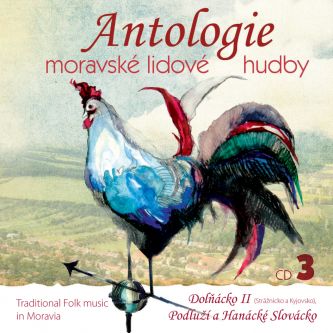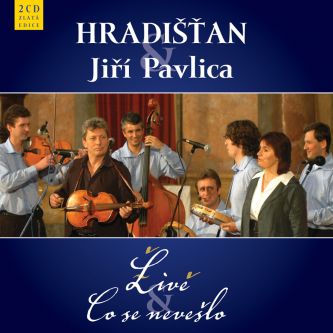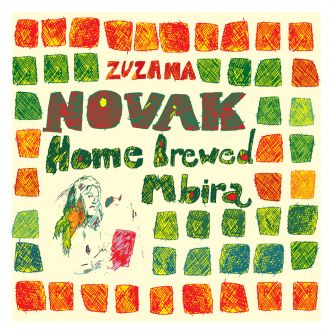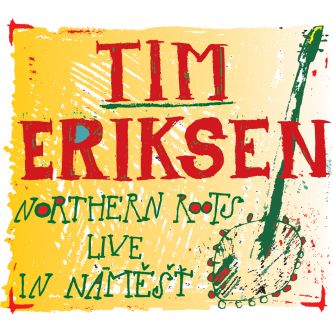
The third album is seemingly the most colorful and also the most controversial; while the other parts of the anthology are relatively homogenous in style (with the exception of distinctive village of Moravské Kopanice), here we symbolically travel the music map across Moravské Slovácko region from border to border and we can again go through the regions already mapped: Strážnicko region has the longest border with Slovakia (and many dulcimer bands, e.g. Strážničan or Danaj, often go there for inspiration, especially to Záhoří but also to Myjava – and how many times there appear Slovak elements in lyrics of love themes, “danajs” and “verbuňks”!) and only a little shorter border with Horňácko region; the village of Blatnice pod Svatým Antonínkem is situated just a few hundred meters from Horňácko region and the ensembles from Kněždub and Hroznová Lhota often accompany bands from Horňácko. The proximity to Slovak songfulness can be felt in both places, many songs are verse by verse the same, and they only differ in rhythm and nuances of melody... Strážnicko region is, in my opinion, closer to Horňácko region than to Kyjovsko region, in case of Uherské Hradiště region; the music competition is not that fierce. Kyjovsko region is the one which has to defend itself the most: Bzenec on the very border of the region is closer to Moravský Písek and from there it’s just around the corner to Veselí, on the other side just outside the border there is the Hodonín of Podluží region situated and from Svatobořice and Mistřín it is very close to Hanácké Slovácko region (not even mentioning Čejč and Hovorany). Similarly, some micro-regions of Hanácké Slovácko region are very influenced by Podluží region – for example the border village of Čejkovice, Dolní Bojanovice, Velké Bílovice, Velké Pavlovice … this part of the region is ruled by brass bands, even if the old tradition says something else: the oldest musicians used to be the pipers. The Podluží region itself, seemingly completely closed to outside influences is colorful and diverse in its folk music. The largest region is the Hanácké Slovácko region; this region is rightly called “shadowless region” (and a regional ethnographic music festival is called the same) and it’s not only bountiful in fields, orchards and vineyards, but also in national songs. Hanácké Slovácko region is a term relatively young for ethnologists – in the last century collectors still named the particular micro-regions of Bílovsko, Klobucko and Hustopečsko in their song records.
Strážnicko region, Strážnice itself with close villages of Petrov, Radějov, Kněždub, Tvarožná and Hroznová Lhota and Vnorovy (Znorovy until recently, as the poet Jan Skácel used to write about his native village) – these are very important centers. Strážnice is a symbol of folklore of the entire Moravia; there is more than half-century long tradition of international folklore festival, a place where there is located a large open-air museum of folk architecture and above all there is a very long history of numerous singer and musician families – all this is Strážnicko region; the pair dance danaj and the male solo dance of young conscripts called verbuňk, since 2005 registered as cultural heritage of UNESCO.
Kyjovsko region, divided into northern and southern part by a main road, the “upper” and “lower” part, bellow and above Kyjov, is also linked with tradition: its part close to Podluží, Mistřín, Vracov and Ratíškovice still have the Slovácko character of songfulness, above Kyjov, the music is much closer to Hanácko region tradition. In Horňácko and Podluží region there is the piper tradition (even though little different one), in Kyjov region there is the long tradition of dulcimer bands. As Jiří Plocek states in the sleeve note for the album Na Kyjovsku, the oldest written record about a dulcimer in Kyjov region refers to the dance in Skoronice in April 1799 when a group of soldiers forced the band to play by throwing in money into dulcimer. After all, the dulcimer preserved here after Josef Smetana from Uhřice has (a credible) marked year of 1786. The dulcimers were of course either table dulcimers or pendant ones. At the same time there were of course both dulcimer and brass bands and musical “amphibians” who could handle both instruments, string and brass ones, in particular villages. The dance form typical for Kyjov region is the local variation of the pair dance called danaj, the svatoborský danaj – other dances are the Kyjov slovenská, skočná, verbuňk, po holénce and vrták.
Podluží region with Hodonín and Kyjov as its centers, larger villages are Lanžhot, Moravská Nová Ves and Dolní Bojanovice, is typical for its high pitched long-drawn melodies sung by strong resonant male voices – in general, the cult of high male voice is developed here. The typical thing in Podluží region is polyphonic voice in sixths and top thirds. Unlike in other regions of Moravian Slovácko, in Podluží region there is prevalence of long-drawn songs over fast dance melodies. According to the records, piper bands in the beginning of the 19th century consisted of a piper accompanied by two violinists – the bandmaster and the “kontráš“, who were later completed with a clarinetist and a bassist. In the second half of the 19th century tin instruments were added to the band to reinforce the sound (these bands were called štrajch); after the Second World War there was a rapid statesponsored development of brass bands at the expense of traditional music ensembles. In Podluží region they dance the pair dance called vrtěná, the solo boys’ dances are (as everywhere) verbuňk and hošije. The other preserved ceremonial dances in Podluží region are žabská, šátečková and hejnom.
Hanácké Slovácko region is approximately defined by a triangle of towns Hustopeče-Krumvíř-Čejč. Also belong here the villages of Klobouky, Diváky, Morkůvky, Brumovice, Bořetice, Čejkovice. Even in this region the historically first accompanying instrument were “gajdy” (Moravian bagpipes) later accompanied by one violinist and perhaps by a dulcimer player. The typical pair dance of Hanácké Slovácko region is the (klobucká) skočná (different one than in Kyjov region), a unique ceremonial dance is zavádka (which introduces first the “stárky“ then the other girls to dance under the “májka“). In opposition to urban centers of surrounding regions the cultural center of Hanácké Slovácko region is Krumvíř, relatively ancient village of a respected musical tradition; in local amphitheater there is held every year the renowned ethnographic exhibition entitled Kraj beze stínu / Shadowless region.
01.Bánovce (pochod dle muziky Jana Horného – instrumentální)
hraje Strážnická cimbálová muzika Danaj, prim Jan Gajda, CD CM Danaj: Janíčku náš, Janku
02.Vyletěl fták (milostná ze Strážnice)
zpívá Jan Gajda, hraje Strážnická cimbálová muzika Danaj, prim Jan Gajda, CD CM Danaj: Písňovou zahradou
03.Toto je tá cesta (danaje ze Strážnice)
zpívá Jan Gajda a sbor muziky, hraje Strážnická cimbálová muzika Danaj, CD CM Danaj: Gajdování
04.V širém poli hruščička (balada z Kněždubu)
zpívá Magdalena Múčková, hraje Strážnická cimbálová muzika Danaj, CD CM Danaj: Janíčku náš, Janku
05.Bože môj, otče môj
zpívá Pavel Múčka, hraje Cimbálová muzika Pavla Múčky ze Strážnice, CD CM Pavla Múčky ze Strážnice: Při strážnickej bráně
06.Zabila panička pána (balada v tanečním rytmu ze Strážnice)
zpívá Magdalena Múčková, hraje CM Pavla Borovičky z Rohatce, CM Pavla Borovičky: Kdes ty byla Andulenko moja
07.Proč vy mňa chytáte (verbuňky z Radějova)
zpívá chlapecký sbor muziky, hraje CM Strážničan, prim Vít. Pálenský, CD CM Strážničan: Šla psota přes hory
08.Vím já o děvčině (milostná z Petrova u Strážnice)
zpívá Tomáš Pánek, hraje CM Strážničan, primáš Vítězslav Pálenský, CD CM Strážničan: Šla psota přes hory
09.Co sa to tam šustá - Co sama ženička - Neshoda na šohajka (škádlivé ze Strážnicka)
zpívají T. Pánek, V. Pálenský a sbor muziky, hraje CM Strážničan, CD CM Strážničan: Šla psota přes hory
10.V Kněždubě na rohu (danaje ze Strážnicka)
zpívá Václav Harnoš a sbor muziky, hraje Strážnická CM Michala Miltáka, CD Krev země. Lidové písně o víně
11.Brodí Jano koně (verbuňk ze Strážnice)
zpívá sbor muziky, hraje Strážnická cimbálová muzika Michala Miltáka, CD Dyž si já zazpívám
12.V kopčanskom rybníčku (verbuňk)
zpívá Pavel Jurásek a sbor muziky, hraje Strážnická cimbálová muzika Michala Miltáka, CD Dyž si já zazpívám
13.Bože můj nebeský (baladická svatební z Hroznové Lhoty)
zpívá ženský sbor Lipina z Hroznové Lhoty, CD Ženský sbor Lipina z Hroznové Lhoty: Štyry noce nespala sem
14.Z druhej strany potoka (dívčí svatební z Hroznové Lhoty)
zpívá ŽS Lipina, hraje Horňácká CM Libora Supa, CD Ženský sbor Lipina z Hroznové Lhoty: Štyry noce nespala sem
15.Ta kyjovská brána (verbuňk)
zpívá Mužský sbor z Kyjova, hraje CM Jury Petrů, CD Mužský sbor z Kyjova: Dej nám bože zdravíčka
16.Tý kyjovští páni - Už je to legrúti (verbuňky)
zpívají Jiří Frolec a Jiří Petrů, hraje Cimbálová muzika Jury Petrů, CD 60 let s muzikou Jury Petrů
17.Z Ježova jedú (lidová z Ježova)
zpívají Anna Kyliánová a Marie Šoupalová, hraje Cimbálová muzika Jury Petrů, CD 60 let s muzikou Jury Petrů
18.Proč, krušinko, v břehu stójíš (milostná od Osvětiman)
zpívají Jana Krýsová a Věra Mičková, hraje Cimbálová muzika z Osvětiman, CD Osvětimanská muzika (1974-2004)
19.Ach, Bože z nebe (žertovná z Kyjovska)
zpívá Blažena Potyková, hraje Cimbálová muzika z Osvětiman, CD Osvětimanská muzika (1974-2004)
20.Dobre kosénka, dobre kosí
zpívá Mužský sbor Kyjov, CD Lúko, lúko, lúko zelená. Setkání folklorní sborů v Buchlovicích
21.Už je slunko z tej hory ven
zpívá Mužský sbor Vacenovice , CD Lúko, lúko, lúko zelená. Setkání folklorní sborů v Buchlovicích
22.Milostné skočné – Za naším huménkem - Jede šohaj z Vídňa - Hory, hory, horyčky - Ej, vím já o děvčině
zpívá sbor bratří Varmužů, hraje Varmužova CM z Mistřína, CD Varmužova cimbálová muzika: Na Kyjovsku
23.Pošla děvěčka do jazerečka - Chodili chlapci k nám
zpívá Hedvika Varmužová, hraje Varmužova CM z Mistřína, CD Varmužova cimbálová muzika: Písničky z domu
24.V poli stójí Anička (verbuňk z Ratíškovic)
zpívá Josef Varmuža ml. a sbor bratrů, Varmužova CM z Mistřína, CD Varmužova cimbálová muzika: Písničky z domu
25.U Prešpurka, u Dunaja (verbuňk)
zpívá Jožka Severin ml. a sbor muziky, hraje CM Jožky Severina, CD CM Jožky Severina: A já dobře vím …
26.Vrť sa, dívča, vrť sa (milostná taneční)
zpívá Jaroslav Kovářík, hraje CM Břeclavan, prim Jožka Kobzík, CD Jaroslav Kovářík, zpěvák z Kobylí
27.Kázali mě rodičové (verbuňk)
zpívá František Studenka, CD A já mám frajerku. Písně z Podluží zpívá František Studenka
28.U Lanžhota na dolině (táhlá)
zpívá Martin Moravanský a Martin Kaňa, hraje CM Zádruha, CD CM Zádruha z Dolních Bojanovic
29.Štyry koně vraný lysý (táhlá z Velkých Bílovic)
zpívá Jaroslav Kovářík, sólo cimbál Jan Rokyta, CD CM Vonica 2000
30.Neber sobě, můj synečku - Néni lepší jako žena mladá
zpívá Jaroslav Kovářík, hraje CM Zavádka z Čejkovic, CD Jaroslav Kovářík, zpěvák z Kobylí
31.Brumovice na pěknej rovince - A v tem Brně prostřed rynku (milostná)
zpívají Jan Zaviačič a sbor, prim František Koráb, hraje CM Vonica z Krumvíře, CD CM Vonica 2000
32.Grumvířská dědina
zpívá František Koráb a sbor muziky, hraje CM Vonica, prim Antonín Bukovský, CD CM Vonica Krumvíř
33.Kanafaska a hustopečská (hanáckoslovácké tance)
hraje Cimbálová muzika Vonica Krumvíř, prim František Koráb, CD CM Vonica Krumvíř

| CD | € 13.72 |
| MP3 | € 6.03 |
| FLAC+mp3 | € 8.05 |

| CD | € 9.67 |
| MP3 | € 4.00 |
| FLAC+mp3 | € 6.03 |

| CD | € 10.28 |
| MP3 | € 4.00 |
| FLAC+mp3 | € 6.03 |
